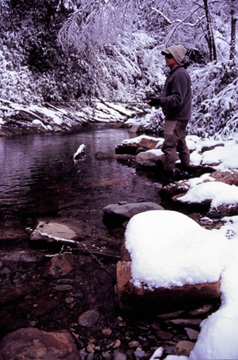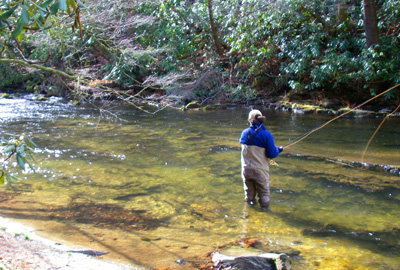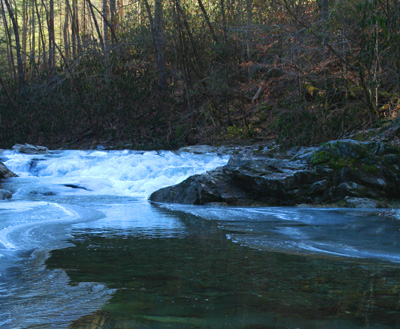Winter is among the toughest times of year to catch trout in streams. Water temperatures are cold and a trout’s metabolism is slow. Even though a fish doesn’t need to feed as much in cold weather, they will eat if given a chance.
Fly fishing in the winter is different than spring, summer, and fall. Nymphing skills are more important now than any other time of year. Here is our best advice for catching trout on nymphs in the winter.

1. Fish the middle of the Day – Fishing is rarely very good before 9:00 AM in December, January, and February. In fact, fish may not be moving around much until 11:00 AM or noon. Trout will move most after water temperatures have risen a few degrees. Aquatic insects also move around a little more when things warm up a bit and this gives the fish the best reason to clock into work. Fishing often slows down by 3:30 or 4:00 but can continue to be good right up until dark on unseasonably warm days.
2. Choose the Water you Fish Wisely – Any angler who is skilled at reading the water will always outfish another who isn’t as discriminating. This becomes even more important when fishing in the winter. Shallow riffles and long stretches of pocket water don’t give up trout as generously in the winter as other seasons. Skip swift water lies in favor of slower flows. Trout move to the swifter water when food is more plentiful, but lie in slower water when insects aren’t very active.
One of the best spots is the point where a shallow riffle transitions to deeper, slower water. Cast the fly into the riffle so it has time to sink and falls naturally into the deeper water.
Also keep an eye out for slow pockets in stretches of pocket water. Not all pockets will be productive, but some might give you the best opportunity of the day. Patches of dead water framed by swift water are prime.
Watch for stretches of water that receive plenty of sunlight. Direct sunlight provides a little extra warmth to get both bugs and fish moving. We often spend winter days chasing sunny spots and will occasionally find a few rising trout.

Fish during the warmest part of the day and try to find sunny spots where fish may be more active
3. Plan Your Fishing Around the Weather – Most anglers fish when they can and squeeze a day into a busy schedule when possible. Keep an eye on the extended forecast during the winter months and try to hit the water on a day that will optimize your chances for success. A string of cold nights with temperatures in the teens and daytime temperatures that struggle to rise into the mid 30’s are sure to provide slow fishing.
Water temperatures in freestone mountain streams will often plunge right down to the freezing mark. This is sure to produce a “lockjaw” pandemic among the trout population. Trout are only marginally active when the water gets below 40 degrees. We see the biggest activity swing between 40 and 42 degrees. Fishing is pretty good at 42 but noticeably slower at 40. Get down to 38 or 39 and fishing is extremely slow.
One of the best weather features to watch for in the winter is a period of rain when the overnight temperatures stay in the 40’s or barely dip into the 30’s. A rainy 45 degree day brings relatively warm water into a stream and can get fish and bugs moving. This can jump start a stream after a long cold snap and even keep a stream warm for the first day after temperatures have made a sudden dip.

Even waterfalls start to ice up when the water is 32 degrees. Fishing is guaranteed to be slow when the water is this cold.
4. Use Split Shot – No other piece of equipment is as maligned by fly fishers as split shot. This is in spite of the fact that we find it more useful than almost anything else in the winter. A $5 – $10 investment in split shot will go much further toward catching trout in cold weather than a much pricier investment in rods or reels.
We typically use shot in sizes 4, 6, or 8 depending on the depth and velocity of the water. Pinch it on your tippet 6″ – 8″ above the fly or in between two nymphs tied as a dropper. This will ensure that your flies sink to depth quickly. A fly that sinks quickly is a fly that is in the strike zone sooner and stays there longer.
5. Use the Best Strike Indicator For the Job – Expect subtle takes from the fish. This requires a strike indicator that can support the weight of heavy nymphs. If you use a strike indicator that sinks under the surface on every other drift you’re very likely to miss a soft strike when a trout does eat. You might even realize it was a fish, only too late to get a good hook set.
Yarn can be a good choice but be sure it’s a big piece. Foam footballs and other other indicators made from high floating materials are the best choice. Sticky pinch-on indicators don’t allow for depth adjustment and are sometimes too small to float a heavy rig.
6. Try Fishing Without a Strike Indicator – Many fly fishers are surprised to hear us say that no strike indicator might be the best way to go. This isn’t a technique we recommend for inexperienced anglers, but those who are already skilled at high stick nymphing with a strike indicator may be surprised at how effective this can be. Strike indicators place a limit on just how deep your nymphs can go and might place a limit on just how effective you can be.
Start out by trying this technique in slow pockets with short casts. Be sure your rod tip is downstream of your nymphs. Use only the minimum amount of line necessary. There should be no extra line on the water. Move your rod tip downstream at the same speed your nymphs drift in the current.
Most fly fishers are shocked at how obvious the strike is. Your leader and the short amount of fly line you are using will twitch or even jump upstream. Another benefit is that you can actually feel your nymph bouncing along the bottom. Just a little practice with this technique will make any fly fisher more effective with nymphs.
7. Use Heavy Tippet – Some fly fishers are extremely conscientious about using the lightest tippet possible so fish won’t see it. This is fine when fishing tiny midge patterns to cautious tailwater sippers in slow water. Light tippet has no benefit in cold mountain streams. Most fish eat size #8 – #14 flies better than those in the range of #18 and smaller. This is probably because the fish are opportunistic and they see the larger patterns better.
Heavier tippet casts heavy nymph rigs better than light tippet. A leader with two nymphs, a split shot, and a strike indicator is naturally clumsy to cast and stiffer tippet helps it turn over better. We generally use 3X on flies down to #8 – #12, 4X on sizes #12 – 14, and 5X on sizes #14 – 16.
8. Use a Dropper Rig – If the fishing will be slow you should do everything to maximize your chances for a hook up. One of the best ways we know is to fish two flies.
There are two big advantages associated with fishing a couple of flies. The first is that you can fish two different flies to a single fish with one drift. Sometimes fish will have a definite preference for one fly over another.
The second advantage is that you can fish two flies at different depths on the same drift. We like to fish a #8 – #10 stonefly pattern on bottom and a smaller beadhead on top. This allows you to present a fly deep for the fish glued to the bottom and another fly higher in the water column for those fish watching for emerging mayflies or caddis.
9. Try Fishing a Streamer Like a Nymph – This is something that doesn’t require a new skill set for fly fishers but is rarely done. You can simply fish a Woolly Bugger or Muddler Minnow under a strike indicator or add a new dimension to your tight line nymphing without an indicator.
We’re strong advocates of putting action on streamers, but they will do better in the coldest conditions with little to no action. After the dead drift you can allow the line to come tight and fish the swing.
Those who opt to use the tight line nymphing method should consider giving the streamer a slight twitch with the rod tip when they feel it tap bottom. Most strikes come when the streamer shows a small sign of life.
10. Stocked Trout are Far More Active in the Cold than Wild Trout – We’re sure there’s a biological reason for this, but stocked trout will continue to feed in the coldest water when wild trout have completely shut down. Our best theory is that stockers don’t have as much survival savvy. They continue to forage for food even when wild fish seem to know it’s a waste of energy when there are no insects moving about.
We’re strong advocates of fishing for wild fish, but if you can only get out during the coldest weather you’re going to have better opportunities to hook some fish on a stocked stream.
Ian says
Brandon, I’m not familiar with Onenote, but we’ll add this to our articles page and you can find a link to it there.
Brandon says
Great article. Put it into Onenote so I can reference it anytime. Thanks for putting it up!
Ken says
I am currently planning a family vacation down to the Smokies that will include a littel fishing. We are not going till March so hopefully things will have warmed up a bit but I suspect many of the tips you have provided will still apply.
Enjoyed the article.
Thanks!
Ron Gaddy says
This article “Our Top 10 Tips for Fly Fishing with Nymphs in the Winter Months” is awesome. I’ve just started out fly fishing and it could take you years to figure some of this stuff out. For those of you that want to catch trout in high water/winter months… pay attention!
This guy is good!